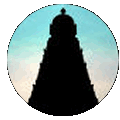 |
 |
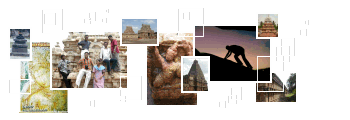 |
http://www.varalaaru.com A Monthly Web Magazine for South Asian History [187 Issues] [1839 Articles] |
 |
 |
 |
http://www.varalaaru.com A Monthly Web Magazine for South Asian History [187 Issues] [1839 Articles] |
|
Issue No. 136
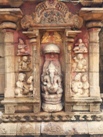
இதழ் 136 [ ஆகஸ்ட் 2017 ] 
இந்த இதழில்.. In this Issue.. 
|
CHANDRASEKARASWAMI TEMPLE SCULPTURES THE HARA OF THE FIRST TALA The nasikas in the hara elements and the harantara are adorned with bas-relief sculptures. On each side there are seven nasikas, totally constituting twenty eight in number and each nasika is adorned with either male or female bas-relief sculptures. All are seated in lalitasana with their one leg folded flat on the floor and their other leg folded upright, but in various postures. Some are shown with their lower body in profile posture and their upper body is either facing straight or half way to straight. Their lower garment is a drapery extending up to their ankle or a half wear extending upto their knee or thigh. Besides, some are also adorned with idaikattu over the lower wear. The yajnopavita is worn in upavita fashion. Their ears are elongated lobes and with either pootu or patra kundalas, and the other ornaments adorn by them are chavadi or charapali, bangles, armlets, udarabanda, head patta. For some of them their ornaments are beaded. For the men, locks are gathered and knotted in jatabandha fashion and for few decked as karanda makuta, especially those adorning the alpa nasikas of the karnakutas. For the females, the locks are gathered and knotted either in kunthalam fashion (knotted in the side head) or thamizham (knotted in the back head). THE ALPA NASIKAS IN THE KARNAKUTAS In each karnakuta two alpanasikas are on visible side, except one all the nasikas of the karnakutas are adorned with male figures, the north facing nasika in the northwest corner karnakuta is the only one adorned with a female. Posture, attire and ornaments are as mentioned in the general description. Among the two male figures adorning the southeast corner nasikas, a rishi is seen seated in profile posture on the southern side, his left hand is folded up and in chin mudra, while his right hand is placed on the right thigh in twisted posture. He is adorned with short attire, idaikattu, vastra yajnopavita. Ears are elongated lobes without kundalas, and udarabanda is also absent. His locks are gathered and knotted in jata bandha fashion. On the eastern face, the male in slight grin is seated in profile posture facing south while the right hand is folded up and in kataka, his left hand is stretched and placed on his right thigh. His nonchalant smile and posture adds poise to him. Both the male adorning the southwest corner karnakuta are decked with short attire and all usual ornaments, but karanda makuta is adorn by the west facing male, whereas for the other the locks are gathered and knotted in jatabandha style. While the former is carrying a flower in his left hand which is in kataka, his right hand is placed on the right thigh, whereas the latter is carrying a gadha on his right hand and his left hand is showing kataka. Comparing the two the one on the west face is more adorable. The nasikas on the northwest corner is adorned with a female on the north face and a male on the west face. The north facing nasika is depicted with a female, feeding an infant. The infant is seated on her right lap holding and suckling from her left breast. Her posture and expression exhibits her unpleasant feeling over the feeding, her head is tilted up and her face in weird expression, her left hand is raised up and holding her locks while her right hand is placed down near the infant. This feeding female-infant can be the depiction of Krishna-Putna puranic theme. While the male on the west face is eulogizing in his right hand, his left hand is positioned near his chest and in kataka. Both the male on the northeast corner karnakuta have placed their right hand on their thigh and their left hand is folded up and in kataka, the male on the north face is holding a flower on his left hand. Both are adorned with karanda makuta and decked with all the other accessories as mentioned in the general description. Both are in profile posture, but the male on the north face has his head weirdly tilted up. THE KSHUDRA NASIKAS IN THE HARANTARA
On the eastern side, to the south of the koshtha a pair of male and to the north of the koshtha a pair of female are seen, but the sculptures are partially concealed by the mandapa roof. Both the females are in slight grin, while the one adjoining the koshtha is in profile posture facing the neighbour, her left hand is in vismaya, her right hand is not visible. Whereas the other female seated facing straight with her head slightly tilting left, has placed her right hand on the right leg while her folded left hand is setting the untied locks. The locks of the former is gathered and knotted in the apex while for the other it is floating on the shoulder. Their seated posture and gestures signify as if they are in converse, the one adjoining the koshtha is expressing something while the other listening tranquilly. The two male to the south of the koshtha also looks as if in interaction. Both are seated in half way turned posture facing each other, while the one adjoining the koshtha is with mustaches, his right hand raised up and eulogizing whereas his left hand is in kataka. The other male has planted his left hand on the floor and his right hand is in chin mudra.
On the northern side, the nasikas to the west of the koshtha are adorned by females and the nasikas to the east of the koshtha are adorned with males. Both the male are carrying a club, the one adjoining the koshtha seated in profile posture facing his companion, is resting his left hand on the club while his right hand is in vismaya. His wide open mouth with a smile and his hand gesture indicate that he is expressing something. Whereas the posture of other male looks interesting, he has placed his both hands on the club which is planted on the floor and he is resting his head on the hands. It looks as if he is in a nap.
Both the female on the nasikas to the west of the koshtha are young, decked in short attire, idaikattu and ornaments, but breast band is absent. Their locks are gathered and knotted on the left side for one female and on the apex for the other. The female adjoining the koshtha is looking trance in mood; in a bright smile with her head slightly tilted on one side and her right hand on her cheek. Whereas the other female might be admiring her beauty; is holding a mirror on her left hand and her right hand is holding her knotted locks.
On the western side two male are shown to the south of the koshtha and a male and a female are depicted to the north of the koshtha. Among the two male, the one adjoining the koshtha has placed his right hand in chin mudra near his chest while his left hand is planted firmly on his left thigh, whereas the male next to him is in anjali hasta. Both are adorning jatabandha, short attire and the male in chin mudra is decked with beaded mala. They look calm and devout.
The pair on the northern side looks as if in conversation; the male has placed his right hand on his left thigh and his left hand is stretched on the right side in folded posture and in the gesture of vismaya. His facial and hand gestures indicate his interaction with the female next to him. On the other hand, the female looks bashful with her head tilted left and resting on her left hand, while her right hand is placed on her right leg. In bright smile she looks as if enjoying the comment of her companion, the gestures revealing her contentment with shyness.
On the southern side, to the east of the koshtha a female and a monkey are seen whereas to the west of the koshtha a female and male are shown. The female and monkey combination is the Ramayana Asokavana scene of Sita-Hanuman. Sita in grief is expressing her state and Hanuman with folded hands piously listening to Sita.
The male and the female on the western side are seated in profile posture towards east, the female seated in poise with a parrot on her left shoulder and her hands casually placed. Whereas the male has placed his right hand on his right thigh but the gesture in the left hand is not clear. THE NASIKAS OF THE BHADRA SALAS The nasikas in the bhadrasalas, each one on the four directions carry male bas relief figures. Except the one on the eastern side, all the others are seated in lalithasana with one of their hand planted on the floor and their other hand placed on their leg which is folded upright. Their locks are gathered and knotted in the apex and also adorned with all usual ornaments. On the eastern side a deity is seen, adorning karanda makuta and silk attire, holding objects on the back hands and the front right hand is in abhaya while the front left hand is placed on the thigh. The sculptures of the nasikas are excellent workmanship, exhibiting the prodigy of the Early Chola sculptors. Various moods, gestures, themes are perfectly brought forth in their creation. Puranic themes find place in the depiction, still, much importance is given to casual life style like women in poise or in interaction, men in interaction, by which the sculptors mirrored the early medieval society. But the colour wash totally spoiled the clarity and grace of the sculptures.
|

சிறப்பிதழ்கள் Special Issues 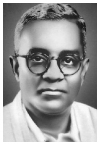

புகைப்படத் தொகுப்பு Photo Gallery 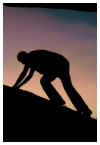
|
| (C) 2004, varalaaru.com. All articles are copyrighted to respective authors. Unauthorized reproduction of any article, image or audio/video contents published here, without the prior approval of the authors or varalaaru.com are strictly prohibited. | ||